In three issues in late 1998 and early 1999, Practical Sailor devoted considerable space to the subject of radome mounts.

Despite all the splendid effort, several readers in the Seattle area sent reminders that one mount was overlooked. They said its high quality suggested that it should not be ignored.
If you recall, mast radar mounts were assessed in the September 1998 issue, and the Scanstrut was the top choice.
The review of gimbaled backstay mounts was in the October 1, 1998, issue. The Questus was deemed a jewel, but the Waltz was the Best Buy.
The pole mount report was in the February 15, 1999, issue. Forespar was the “Top Pole,” Edson offered the most complete line and Garhauer, with a new mechanical leveling mount, was the Best Buy.
One more bit of history: A PS mini survey revealed that the ratio of mast/backstay/pole mounts was 61%/17%/22%. A “wish-I-had” question in the survey indicated that mast mounts were deemed less desirable than backstay and pole mounts, mostly because mast-mounted radomes do not co-exist well with flailing jib leeches, errant sheets and loose halyards, and are difficult to service.
With the situation now updated in 200 words or less, it is time to introduce to PS readers Wolfgang Bernardy, who prefers to be called “Bernie,” which is understandable.
Born in Germany and apprenticed at age 14 in electronics, Bernardy came to the United States in 1956 and learned to machine aluminum in a long career with Boeing.
His Yachting Specialties Northwest is in his two-car garage, where he and his two employees work. He uses several outside contractors, carefully chosen to meet his specifications.
For instance, the corners of the aluminum parts carry machined chamfers measuring 80/1000″. That kind of relieved corner, done with sharp cutters, is so smooth it requires neither deburring nor polishing before getting (from another contractor) the heaviest anodizing possible without introducing discoloration.
He offers a single 8′ model (a 10′ pole is available for through-deck mounting), but it has many options.
The 2-1/2″ OD pole and 7/8″ support struts are made of stainless steel. Most other parts are machined of marine grade aluminum, which is preferred to the type 356 cast aluminum used for so much marine hardware.

The deck-mount pole has a two-axis hinged base that adjusts to any deck camber (and to lower the pole), and for the struts, a clever ball swivel that can accommodate any attachment angle.
“I worked for a few years making custom installations,” Bernardy said, “but they require a lot of tinkering, and they’re rarely perfect. So, I worked out these rocker fittings. Besides making it easy, they are excellent fits…with the added advantage that they don’t flex the deck as severely as rigid fittings.”
Further indicative of the quality of the unit, the strut collars (machined from solid blocks of aluminum, of course) have expandable Allen-head pins that when finally tightened, prevent rattling.
The pole is really a sturdy tripod, rather than, as often seen, a pulpit-mount with a fixed base and reinforcing struts. Bernardy does not think that a radome mount should be affixed to a pulpit or stanchion.
Bernardy takes some pride in the fact that none of the parts have slot adjustments, optional holes or notches.
“With good engineering,” he said, “there is no need for such troublesome details. Precision fits mean long life and less corrosion.”
For the through-deck pole, the deck flange and below-deck support are standard options. To suit the extreme angles of reverse transoms, custom machined parts are routine options.
For the top end, the radome mounting plates are machined cutouts (to save weight) from 3/8″ aluminum plate. The support arms for accessories come in three lengths and are milled from 1/2″ aluminum plate. The arms (up to three can be fitted) support any number of antennas, navigation lights, flood lights, etc.

All parts are machined to fit exactly Raytheon, Furuno, JRC and other radar sets, Aqua Signal lights, Jabsco floodlights, KVH’s “Track Vision” and other equipment.
The basic pole, complete with struts and bases, sells for $734.50. Radome mounting plates are $98.25. Accessory arms range from $97.50 to $120. Light brackets are about $25.
A fairly complete radome pole, for the average number of accessories, runs up past $1,000.
Compared with a heavyweight Garhauer pole (which sells for as little as $250), it’s expensive. But compared with a top-of-the-line Edson or a Forespar lightweight pole (either of which might go more than $2,000), Bernardy’s pole is modestly priced.
If you like top-flight workmanship—tight fits, beautiful machining and great anodizing—this might be to your liking. If so, contact Bernardy at Yacht Specialties Northwest, 36628 25th Ct. S., Federal Way, WA 98003, 253/874-8197, fax 253/874-1329.
If a lady answers, you’ll find she knows almost as much about it as her husband. Just say, “Hello, Maureen,” and tell her what you want. If it gets complicated, she’ll fetch Bernie from the garage.







































